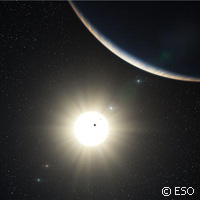Sister solar system discovered
An international team of scientists working from the European Southern Observatory (ESO) in Chile has discovered a neighbouring planetary system that shares many features with our Solar System. The findings, published in the journal Astronomy and Astrophysics, are an outcome of a large-scale survey being conducted with the High Accuracy Radial Velocity Planet Searcher, or HARPS spectrograph. The astronomers and astrophysicists observed five Neptune-sized planets orbiting the Sun-like star named HD 10180, and uncovered evidence of two smaller planets, called super-Earths. This makes it the most populated known exoplanetary system. In addition, the planets are densely packed but sit in well-ordered orbits, similar to the planets in our own eight-planet system. 'We have found what is most likely the system with the most planets yet discovered,' said Christophe Lovis of the University of Geneva in Switzerland. 'This remarkable discovery also highlights the fact that we are now entering a new era in exoplanet research: the study of complex planetary systems and not just of individual planets. Studies of planetary motions in the new system reveal complex gravitational interactions between the planets and give us insights into the long-term evolution of the system.' The HARPS spectrograph, which is attached to ESO's 3.6-metre telescope, is being used to study around 400 bright stars in our solar neighbourhood. In the present study, the high-precision planet hunter was used to take 190 measurements in the area of the dwarf star HD 10180, located 39 parsecs (127 light-years) away in the direction of the Hydrus constellation. The team observed tiny back-and-forth motions of the star, indicating complex gravitational attractions from five or more planets. These motions have specific signatures; the 5 strongest correspond to planets measuring between 13 and 25 Earth masses, about the size of Neptune. The orbit periods of these giants range between 6 to 600 Earth days, putting them all at a distance from their sun no farther than Mars is from ours. Another planet appears to be Saturn-like, and completes its orbit in 2,200 days. The seventh has a mass of around 1.4 times that of the Earth, which would make it the least massive exoplanet ever discovered. This smaller planet is very close to its sun, completing its orbit in 1.18 Earth-days. 'This object causes a wobble of its star of only about 3 km/hour - slower than walking speed - and this motion is very hard to measure,' explained Damien Ségransan of the University of Geneva. Assuming the planet's existence is confirmed, it would join other hot, rocky planets like the recently discovered CoRoT-7b. The discovery of such a diverse set of exoplanets highlights how diverse the outcome of planet formation can be, the authors note. Until now, 15 systems home to at least 3 planets have been discovered. 'Systems of low-mass planets like the one around HD 10180 appear to be quite common, but their formation history remains a puzzle,' said Dr Lovis. Confirming current theoretical models, the researchers also established a relationship between the mass of a planetary system and the mass and chemical content of its host star: very massive planetary systems form around massive and metal-rich stars, while those with very low mass have consistently been found around lower-mass and metal-poor stars. Future measurement studies should confirm the existence of the near Earth-sized hot planet, the researchers believe. The current findings have demonstrated that the radial velocity technique is well suited to the study of complex, multi-planet systems around nearby solar-type stars, and should be able to detect rocky, icy objects. Future instruments like VLTESPRESSO are expected to build on HARPS findings and complete a census of these nearby low-mass systems. In addition, transit studies carried out in space observatories are beginning to confirm that, indeed, rocky/icy planets are very common in the Universe.
Countries
Germany, France, Portugal



